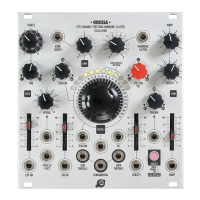4
Odessa features two main outputs of the
synthesized signal: odd partials
20
and
even partials
21
. It is possible to split the
harmonic spectrum so that even and odd
numbered partials are separately present at
those outputs yet always mixed with the fun-
damental partial. An additional fundamen-
tal output
22
offers a simple signal of the
fundamental frequency: either a sinusoid or a
square wave that can be employed for syncing
selects one of these two options.
The two knobs at the top (
23
and
24
) to-
gether with their associated CV inputs
25
and
26
address the distribution of spectral compo-
nents between the odd partials and even
partials outputs. When the bank length
parameter is set to 0, both outputs offer the
same full signal. If set to +1, each output of-
fers the same fundamental (1
st
partial) plus its
even (2
nd
, 4
th
, 6
th
, etc) and odd (3
rd
, 5
th
, 7
th
, etc)
overtones, respectively. With different lengths,
odd and even sequences of partials are split
between the two jacks. Additionally, all par-
tials except the fundamental may be frequen-
cy-scaled by an integer factor: from simple
fractions (1:2, 1:3 down to 1:8) to multiples
(2, 3… up to 8), selected by harmonic fac-
tor. The direction of bank length (either
turned left or right) selects which of the two
unless bank length is 0, which means the
harmonic factor affects both outputs.
Odessa is capable of delivering 1, 3, or 5 stacked
voices of its synthesized signal, selectable by the
voices button
27
. When a single voice is select-
ed (button lit green), the spread knob
28
and
its corresponding CV jack below
29
have no
effect. With 3 or 5 voices (button lit orange or
front panel
overview
2
19
2518
3
28
31
6
1
4
30
29
5

